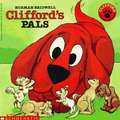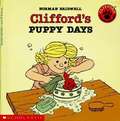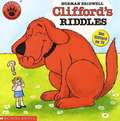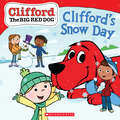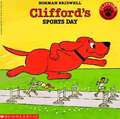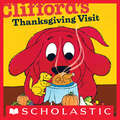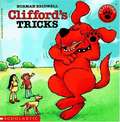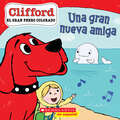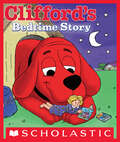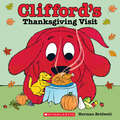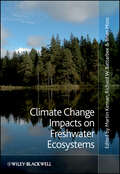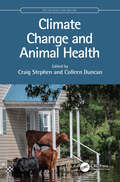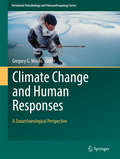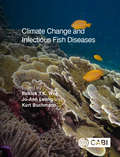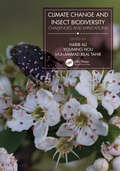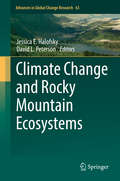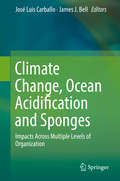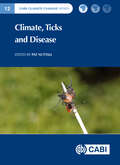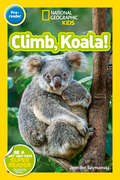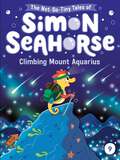- Table View
- List View
Clifford's Puppy Days
by Norman BridwellClifford the Big Red Dog wasn't always so big. Read about his time as a puppy, and the trouble that comes with being small!
Clifford's Snow Day (Clifford the Big Red Dog Storybook)
by Reika ChanEnjoy a snow day with Clifford the Big Red Dog!It's a winter wonderland on Birdwell Island! After a big snowstorm, Clifford and Emily Elizabeth get their first snow day. The best friends have a blast playing Snow Rescue Squad and helping Fire Chief Franklin take care of snow duties across town.But Clifford catches a cold from his busy day outside! The big red dog can't stop sneezing and sniffling. Can his friends on Birdwell Island help him feel better?Featuring adorable art from the new TV show!
Clifford's Sports Day
by Norman BridwellClifford's enthusiasm knows no limits when Emily Elizabeth takes her big red dog to Sports Day.
Clifford's Spring Clean-Up (Clifford Ser.)
by Norman BridwellIn this all-new adventure, he's hard at work getting the house clean. When Emily Elizabeth airs out some throw rugs, he grabs the living room carpet and gives it a good shake--in fact, he shakes it to pieces! What Clifford does best is help clear out the weeds for the vacant lot on Earth Day.
Clifford's Thanksgiving Visit (Clifford 8x8 Ser.)
by Norman BridwellRead all about Clifford's BIG ideas!It's Thanksgiving, and Emily Elizabeth's family is going to visit her grandparents. Clifford decides to go see his mom, who lives in the city. After the Thanksgiving meal, Emily Elizabeth and Clifford both rush home--thankful for each other!
Clifford's Tricks
by Norman BridwellThe New girl next door thinks her big dog Bruno does the best tricks. She is jealous when she sees Emily's giant red dog is at least 20 times bigger than her Bruno. The girls have a dog trick contest between their pets. Bruno fetches the paper, and Clifford brings the whole paper stand and the man who works there. Bruno looks cute and floppy when he plays dead. Clifford looks really dead. Bruno barks a nice arf but Clifford's Bow wow brings scared angry neighbors and police to investigate the great noise. When Clifford rolls over he rolls so fast he smashes anything in his way. Everyone is happy when he does his best trick by saving lives, but at the end of the story each girl is still sure her doggie is the smartest. The silly, colorful pictures have been described by the validator because they add fun to the story. This is a perfect book to read aloud to young children. Blind readers reading the picture descriptions will know what their sighted children are seeing. Beginning blind readers can read the narrative while their parents read the picture descriptions to them.
Clifford: The Big Red Dog
by Norman BridwellEmily Elizabeth introduces readers to her big red dog, Clifford. Limited picture descriptions present.
Clifford: Una Gran Nueva Amiga (big New Friend) (Clifford Ser.)
by Meredith RusuWill Clifford meet a new friend who's just his size? This adorable storybook is based on the animated Clifford TV series!¡Clifford y Emily Elizabeth se embarcan en una aventura!Los dos amigos escuchan la historia de una misteriosa ballena blanca que vive frente a la costa de Birdwell Island. Su nombre es Babette y tiene el mismo tamaño que Clifford, ¡lo que la convierte en la nueva amiga perfecta para el gran perro colorado!Clifford y Emily Elizabeth hacen todo lo posible para que Babette salga de su escondite. ¡Finalmente, descubren que lo que más le gusta a la ballena es la música! ¿Convencerá la canción de Clifford a Babette para que salga a saludar?Clifford and Emily Elizabeth are going on an adventure!The two friends hear a story about a mysterious white whale who lives off the coast of Birdwell Island. Her name is Babette, and she's the same size as Clifford—which makes her the perfect new friend for the big red dog!Clifford and Emily Elizabeth try everything to get Babette to come out of hiding. Finally, they discover that the whale's favorite thing is music! Will Clifford's song convince Babette to come say hi?
Clifford’s Bedtime Story (Clifford Ser.)
by Norman BridwellThis sweet Clifford book will be a must have for bedtime!Getting Clifford the Big Red Dog ready for bed is one BIG job. First Emily Elizabeth gives Clifford a bath in the pool, then she combs his hair with a rake, and cleans his teeth with a big brush. Once the stars are shinning in the sky, Emily Elizabeth reads Clifford a betime story. Before they know it, the best friends are fast asleep.
Clifford’s Thanksgiving Visit (Clifford 8x8 Ser.)
by Norman BridwellCelebrate Thanksgiving with Clifford the Big Red Dog in this storybook favorite!Clifford's Thanksgiving Visit brings readers along as Clifford travels to the city to spend the holiday with his mom. Can Clifford find her apartment in time for Thanksgiving dinner?This classic storybook is back in print with an updated cover!
Climate Change Impact on Livestock: Adaptation and Mitigation
by Veerasamy Sejian John Gaughan Lance Baumgard Cadaba PrasadThis volume addresses in detail both livestock's role in climate change and the impacts of climate change on livestock production and reproduction. Apart from these cardinal principles of climate change and livestock production, this volume also examines the various strategies used to mitigate livestock-related GHG emissions, and those which can reduce the impacts of climate change on livestock production and reproduction. Presenting information and case studies collected and analyzed by professionals working in diversified ecological zones, the book explores the influence of climate change on livestock production across the globe. The most significant feature of this book is that it addresses in detail the different adaptation strategies and identifies targets for different stakeholders in connection with climate change and livestock production. Further, it puts forward development plans that will allow the livestock industries to cope with current climate changes and strategies that will mitigate the effects by 2025. Lastly, it provides researchers and policymakers several researchable priorities to help develop economically viable solutions for livestock production with less GHG emissions, promoting a cleaner environment in which human beings and livestock can live in harmony without adverse effects on productivity. Given that livestock production systems are sensitive to climate change and at the same are themselves a contributor to the phenomenon, climate change has the potential to pose an increasingly formidable challenge to the development of the livestock sector. However, there is a dearth of scientific information on adapting livestock production to the changing climate; as such, well-founded reference material on sustaining livestock production systems under the changing climate scenarios in different agro-ecological zones of the world is essential. By methodically and extensively addressing all aspects of climate change and livestock production, this volume offers a valuable tool for understanding the hidden intricacies of climatic stress and its influence on livestock production.
Climate Change Impacts on Freshwater Ecosystems
by Martin KernanThis text examines the impact of climate change on freshwater ecosystems, past, present and future. It especially considers the interactions between climate change and other drivers of change including hydromorphological modification, nutrient loading, acid deposition and contamination by toxic substances using evidence from palaeolimnology, time-series analysis, space-for-time substitution, laboratory and field experiments and process modelling. The book evaluates these processes in relation to extreme events, seasonal changes in ecosystems, trends over decadal-scale time periods, mitigation strategies and ecosystem recovery. The book is also concerned with how aspects of hydrophysical, hydrochemical and ecological change can be used as early indicators of climate change in aquatic ecosystems and it addresses the implications of future climate change for freshwater ecosystem management at the catchment scale. This is an ideal book for the scientific research community, but is also accessible to Masters and senior undergraduate students.
Climate Change and Animal Health (CRC One Health One Welfare)
by Colleen Duncan Craig StephenThis benchmark publication assembles information on the current and anticipated effects of climate change on animal health. It empowers educators, managers, practitioners, and researchers by providing evidence, experience, and opinions on what we need to do to prepare for, and cope with, the largest threat ever to have faced animals on this planet. With expert contributors from across the globe, the text equips the reader with information and means to develop sustainable adaptation or mitigation actions. After introducing animal health in a climate change context, chapters look at specific animal health impacts arising from climate change. The book concludes with suggestions on teachable and actionable ideas that could be used to mobilize concepts provided into education or advocacy. This book was written amid the COVID-19 pandemic and in the face of ever-increasing reports of on-the-ground, real-life climate impacts. Large scale wildfire and ocean heat waves killed unprecedented numbers of animals while droughts in some areas and floods in others displaced thousands of livestock and made food scarce for even more. Climate change is real, and it is here. How we respond will have profound implications for people, biodiversity, welfare, conservation, societies, economies and ecosystems. Today's veterinary educators are awakening to the need to adapt and train a new generation of animal health professions who can understand and plan for climate change, and this book is an essential resource.
Climate Change and Human Responses: A Zooarchaeological Perspective (Vertebrate Paleobiology and Paleoanthropology)
by Gregory G. MonksThis book contributes to the current discussion on climate change by presenting selected studies on the ways in which past human groups responded to climatic and environmental change. In particular, the chapters show how these responses are seen in the animal remains that people left behind in their occupation sites. Many of these bones represent food remains, so the environments in which these animals lived can be identified and human use of those environments can be understood. In the case of climatic change resulting in environmental change, these animal remains can indicate that a change has occurred, in climate, environment and human adaptation, and can also indicate the specific details of those changes.
Climate Change and Infectious Fish Diseases
by Patrick T.K. Woo Jo-Ann Leong Kurt BuchmannClimate change with global warming is not disputed by the vast majority of scientists and the aquatic system is most affected. A global rise in water temperature and acidification of the aquatic environment will continue even if we can significantly reduce the current output of the two most important greenhouse gasses (carbon dioxide and methane). These and other environmental changes will affect fish health which includes infectious pathogens. This important new text is the second volume on climate change and fish health. It covers changes to the freshwater ecosystem and their current and expected effects on selected infectious diseases of fish. The book represents contributions by over 50 experts from 18 countries. Comprehensive and thought-provoking, the book details abiotic and biotic environmental changes in temperate and tropical freshwater ecosystems, sequestrations of atmospheric carbon dioxide and effects on infectious diseases (12 microbial and 10 parasitic) in economically important fish in tropical, subtropical and temperate waters. The text is key reading for fish disease scientists, aquatic ecologists, fish health consultants, veterinarians, policy makers and all who are interested in fish health and the environment.
Climate Change and Insect Biodiversity: Challenges and Implications
by Muhammad Bilal Tahir Habib Ali Youming HouThis up-to-date reference book discusses the effects of climate change on the biodiversity of insect pests. The changing climate and agricultural intensification practices impact negatively on insect biodiversity. The book explains the significance of insect pests for evaluating climatic impacts on a wide range of ecological systems. It covers the effect of climate change on pollinators and household and agricultural insect pests. It explains how climate-smart agriculture can enhance productivity and food security.FEATURES Reviews the effects of climate change on plant-insect interactions Includes topics such as insect biodiversity informatics and conservation Discusses food security, pest management, and beneficial and social insects Covers topics such as precision agriculture and climate-smart agriculture Provides insights on the relation between agriculture intensification and insect biodiversity This book is meant for scientists, researchers, and students working in the fields of agriculture, entomology, ecology, plant science, environmental biology, and biotechnology.
Climate Change and Livestock Production: Recent Advances and Future Perspectives
by Raghavendra Bhatta Veerasamy Sejian Pradeep Kumar Malik Surinder Singh Chauhan Chinnasamy DevarajThis book describes the importance of sustainable livestock production from a food security perspective in the changing climate scenario. It covers the amelioration of climate change impacts and describes the various mitigation strategies to reduce enteric methane emissions. The book targets sustainable livestock production by covering diverse concepts of amelioration, mitigation, and policy up-gradation. Further, it examines various adverse impacts of climate change on growth, meat, milk, and reproduction in livestock. Most importantly, the book covers novel aspects of quantifying heat stress response of livestock based on non-invasive methodologies, including infrared thermal imaging, sensor-based applications, hair, urine, and fecal cortisol estimation. Particular emphasis was given to describing the skin-based novel approaches to establish climate resilience in indigenous breeds. The book provides detailed descriptions of alleviating climate change impacts on shelter management, nutritional interventions, and genetics-based strategies involving advanced genomic tools. Lastly, it highlights the livestock species which could be considered ideal climate-resilient animal models to withstand the adversities associated with climate change.
Climate Change and Rocky Mountain Ecosystems (Advances in Global Change Research #63)
by David L. Peterson Jessica E. HalofskyThis book is the result of a team of approximately 100 scientists and resource managers who worked together for two years to understand the effects of climatic variability and change on water resources, fisheries, forest vegetation, non-forest vegetation, wildlife, recreation, cultural resources and ecosystem services. Adaptation options, both strategic and tactical, were developed for each resource area. This information is now being applied in the northern rocky Mountains to ensure long-term sustainability in resource conditions. The volume chapters provide a technical assessment of the effects of climatic variability and change on natural and cultural resources, based on best available science, including new analyses obtained through modeling and synthesis of existing data. Each chapter also contains a summary of adaptation strategies (general) and tactics (on-the-ground actions) that have been developed by science-management teams.
Climate Change, Ocean Acidification and Sponges
by José Luis Carballo James J. BellWhile sponges represent a very simple group of organisms, which are represented by over 8000 species, there is considerable interest in the increasing role they may play in future marine ecosystems. While we still have a comparatively limited understanding of how sponges will respond to ocean warming and acidification there is evidence that some species may have the ability to acclimate or even adapt to these stressors. This comprehensive collection of articles describes our current understanding of the impacts of ocean acidification and warming on sponges across multiple levels of biological organisation, and from the geological past to the present. With expert contributions from across the world this book represents the most up-to-date view on sponge responses to climate change. This book will be of interest to a wide audience of marine scientists and managers, who are grappling with how to manage, conserve and protect marine ecosystems.
Climate and Conservation: Landscape and Seascape Science, Planning, and Action
by Charles C. Chester Molly S. Cross Jodi A. HiltyClimate and Conservation presents case studies from around the world of projects focused on climate change adaptation-regional-scale endeavors where scientists, managers, and practitioners are working to protect biodiversity by protecting landscapes and seascapes in response to threats posed by climate change. The book begins with an introductory section that frames the issues and takes a systematic look at planning for climate change adaptation. The nineteen chapters that follow examine particular case studies in every part of the world, including landscapes and seascapes from equatorial, temperate, montane, polar, and marine and freshwater regions. Climate and Conservation offers readers tangible, place-based examples of projects designed to protect large landscapes as a means of conserving biodiversity in the face of the looming threat of global climate change.
Climate, Ticks and Disease (CABI Climate Change Series #18)
by Charles Hart Peter Cox A. Townsend Peterson Nicholas Johnson Wei Liu Jianhong Wu Richard Wall Domenico Otranto Agustín Estrada-Peña Jeremy Gray Abdul Jabbar Jolyon M. Medlock Sunit Kumar Singh Giovanni Benelli Peter Irwin Richard Bishop Xue Zhang Hao Li DeMar Taylor Deborah Hemming Saeed Alasmari Neil Alexander Abdelghafar Alkishe Reiko Arai Armanda Bastos Gervasio Henrique Bechara John Beier Joshua Benoit Dennis Bente Adrien Blisnick René Bødker Fernando Boinas Sarah Bonnet Nathalie Boulanger Alejandro Cabezas-Cruz Alexandre Rodrigues Caetano Cyril Caminade Jirí Cerny´ Roxanne Albertha Charles Ali Reza Chavshin Rosalind Cornforth Neil Coughlan Lauren Culler Milan Daniel Vlasta Danielova Mona Dehhaghi Maria Diuk-Wasser James P Duffy Olivier Duron Lars Eisen Rebecca Eisen Jana Elsterová Koray Ergünay Li-Qun Fang Natalia Fernández-Ruiz Erol Fikrig Serhii Filatov Durland Fish Janet Foley José De Fuente Roman Ganta Aysen Gargili Keles Robin Beat Gasser Abdul Ghafar Naftaly Githaka Lucy Gilbert Maryna Golovchenko Yuval Gottlieb Ernest Gould Libor Grubhoffer Gilles J. Guillemin Kayleigh M. Hansford John E. Healy Stephen Higgs Andrew Hoodless Yan-Jang S. Huang Bernard Hudson Chris Huntingford Esther Kanduma Sirri Kar Maria Kazimirova Neil Kaye Thomas C. Kelly Lene Jung Kjaer Agatha Onyemowo Kolo Eduard Korenberg Nina Król Chi-Chien Kuo Timothy J. Kurtti Xavier De Lamballerie Patrick A. Leighton L. Robbin Lindsay Geoffrey E. Lynn Ilya Maclean Ben J. Mans Maristela Martins de Camargo Karen D. McCoy Ulrike G. Munderloh Atle Mysterud Sukanya Narasimhan Anna Obiegala Dasiel Obregón Alvarez Dr Nick H. Ogden Mari H. Ogihara Stefan Vilges Oliveira Charlotte Oskam Kennan J. Oyen Neha Pandey Hamed Kazemi Panahi John H. Pettersson Martin Pfeffer L. Paul Phipps Heather J. Plumpton Tatjana Pustahija Ram Raghavan Ryan O.M Rego Annapaola Rizzoli Isobel Ronai Franz Rubel Natalie Rudenko Benjamin Ruiwen Rufus Sage Abdallah M. Samy Gustavo Seron Sanches Isabel Kinney Santos Marcello Otake Sato Megumi Sato Richard Schloeffel Seyyed Javad Seyyed-Zadeh Ladislav Šimo Daniel E. Sonenshine Morgan Sparey Frederic Stachurski Snorre Stuen Matias Pablo Szabó Mike Teglas Sam R. III Saravanan Thangamani Georgia Titcomb Attila J. Trájer Michael Turell Rika Umemiya-Shirafuji Dana L. Vanlandingham Laurence Vial Margarita Villar André B. Wilke G. R. Wint Zbigniew ZajacThis book brings together expert opinions from scientists to consider the evidence for climate change and its impacts on ticks and tick-borne infections. It considers what is meant by 'climate change', how effective climate models are in relation to ecosystems, and provides predictions for changes in climate at global, regional and local scales relevant for ticks and tick-borne infections. It examines changes to tick distribution and the evidence that climate change is responsible. The effect of climate on the physiology and behaviour of ticks is stressed, including potentially critical impacts on the tick microbiome. Given that the notoriety of ticks derives from pathogens they transmit, the book considers whether changes in climate affect vector capacity. Ticks transmit a remarkable range of micro- and macro-parasites many of which are pathogens of humans and domesticated animals. The intimacy between a tick-borne agent and a tick vector means that any impacts of climate on a tick vector will impact tick-borne pathogens. Most obviously, such impacts will be apparent as changes in disease incidence and prevalence. The evidence that climate change is affecting diseases caused by tick-borne pathogens is considered, along with the potential to make robust predictions of future events. This book contains: Expert opinions and predictions. Global coverage of trends in ticks and disease. In-depth examination of climate change and tick distribution links. This book is suitable for researchers and students studying zoology, biological sciences, medical entomology, animal health, veterinary medicine, epidemiology, parasitology, and climate change impacts; and for those concerned with public health planning or livestock management where ticks and tick-borne pathogens pose a threat.
Climb, Koala! (National Geographic Kids Readers)
by Jennifer SzymanskiSpend a day with the funny and adorable koala! Young readers will learn all about the basic behavior and habitats of these amazing animals. Through text features such as a vocabulary tree and a wrap-up activity, kids will be introduced to new words and concepts – helping them expand their understanding of the world.
Climbing Mount Aquarius (The Not-So-Tiny Tales of Simon Seahorse #9)
by Cora ReefSimon&’s storytelling takes him all the way to the top of a mountain in this ninth book in The Not-So-Tiny Tales of Simon Seahorse chapter book series.Simon has always loved a good story, but he&’s never heard one quite like Sir Sheldon&’s Mount Aquarius ascent. After his dad tells him the tale, Simon can&’t wait to share it with his friends—with some embellishment, of course. But Simon gets so carried away he ends up announcing his own plans to climb the mountain! Simon immediately regrets the bold claim, but his friends are so excited for him, he can&’t back down. Is Simon really about to face Mount Aquarius? With easy-to-read language and illustrations on almost every page, The Not-so-Tiny Tales of Simon Seahorse chapter books are perfect for emerging readers.
